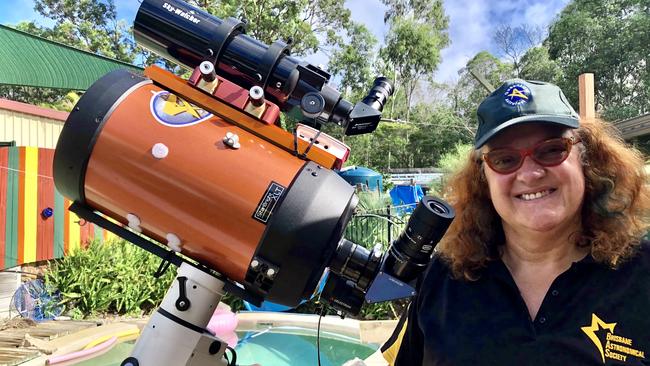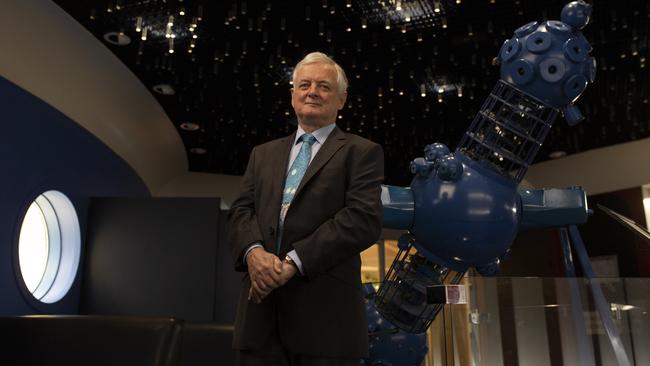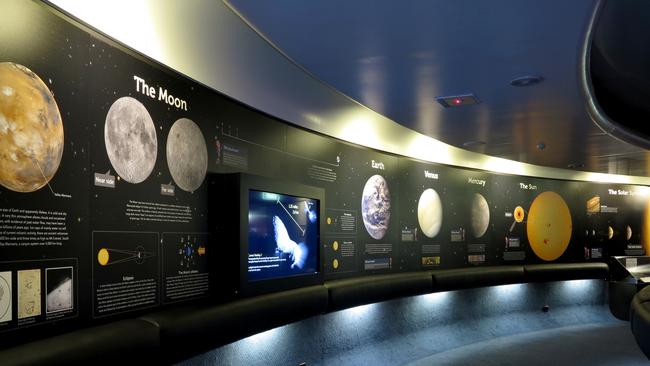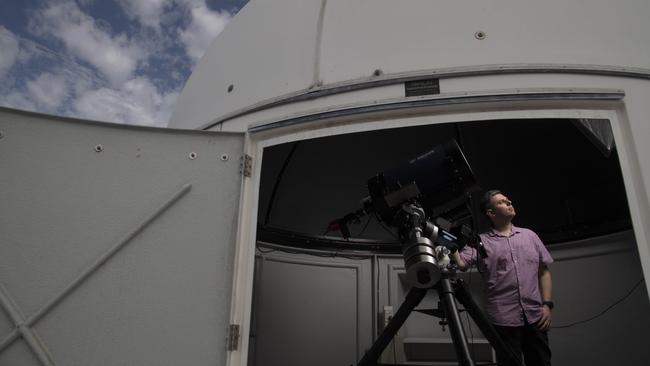Sir Thomas Brisbane Planetarium: Local astronomers on lifelong love for space
Why stay earthbound when a telescopic lens can open up a universe of possibilities? Enjoy the view with Brisbane’s backyard astronomers.

Brisbane News
Don't miss out on the headlines from Brisbane News. Followed categories will be added to My News.
It’s a perfectly clear night atop
Mt Coot-tha and I’m gazing at the Orion Nebula through the eyepiece of a telescope.
This public viewing night is hosted by the Brisbane Astronomical Society and Dazee Dazeford is one of four amateur astronomers who have set up telescopes to give casual stargazers a closer look at The Pleiades, the craters of the moon, and other celestial curiosities.
“Look at that satellite!” someone shouts. I look up to see a point of light arc and vanish. Dazeford got hooked on astronomy a year ago.
“I decided to go buy a telescope … one of those long skinny ones – and I came home with this,” she says, referring to the stout, powerfully built Schmidt-Cassegrain telescope I’ve just peered through.

The childcare worker is now building a backyard observation deck to further indulge her passion. “I’ve just started laying the foundations,” she says.
Astronomy, it turns out, is a highly addictive pastime that is quietly shared by many Brisbanites.
Some even manage to turn it into a career.
Mark Rigby has worked for the Sir Thomas Brisbane Planetarium for the past 35 years – the last 18 of those as curator. Even as a schoolboy, he says, he was “fanatical” about space.
“When Apollo missions were going to the moon, I would have a transistor radio hidden away with an earpiece so I could listen to things,” he says.
On the day of the 1969 moon landing, Rigby skipped school altogether.
“I stayed home for that,” he says.
“There was no way I was going to be beholden to whatever the schedule was at school.”

Rigby’s office is a riot of globes, miniature shuttles and replica rockets.
He wears a tie bedecked with planets. And he still speaks with boyish enthusiasm about the latest developments in astronomy – such as the fading star Betelgeuse.
“Some people think that means it’s ready to explode, a supernova,” he says.
“Most of us think it’s got thousands of years … but we sort of hope we’re wrong.”
The explosion of Betelgeuse would be spectacular – but safe – for Earth dwellers.
“It would look as bright as a full moon,” Rigby says. “Day or night, you’d spot it.”
Rigby points out that Brisbane is the only city in the world named after an astronomer – Sir Thomas Brisbane, a former governor of NSW, who established Australia’s first significant observatory west of Sydney in 1821.
“I think he’d like the Brisbane Planetarium,” he says.

The Brisbane Planetarium contains a “Cosmic Skydome” in which visitors can view astronomically themed shows and take a virtual tour of the city’s night sky. There are also static displays including the Skylore exhibition, which traces Aboriginal and Torres Strait Islander astronomy traditions.
John Pitts, education officer with the Brisbane Astronomical Society, has a similar trajectory to Rigby, in that he recalls being gripped by the Apollo missions.
His parents’ gift of a basic telescope when he was eight years old sealed the deal.
“I knew every planet and how many moons it had,” he says.
The Brisbane Astronomical Society offers its amateur astronomer members monthly meetings and dark-sky viewing nights.
The Society is also very active in offering public outreach activities, including school visits and the Mt Coot-tha public viewing night.
Pitts has passed his enthusiasm on to his three children, and even carried on the tradition of truancy that rare planetary events demand.
“I actually wagged school with them once when they were in high school,” he says.
“I said, ‘You’re not going to school this morning, because there’s a transit of Mercury’.”
Through school visits and other events, Pitts inspires astronomical interest in others.
“I just love the look on people’s faces when they see Saturn for the first time … you can see the rings and some of the moons.”
Professor Brad Carter, director of the Centre for Astrophysics at the University of Southern Queensland, says Brisbane is perfectly positioned for stargazing.
“The southern night sky happens to be much richer in stars than the northern hemisphere thanks to the centre of our galaxy, the Milky Way, passing slowly overhead during winter evenings as the Earth turns,” he says.
“We also can see with the naked eye two nearby galaxies called the Magellanic Clouds in the far southern sky during summer evenings.”

In a digitised world in which cameras and computers are used to gather and analyse research data, professional astronomers have no need to peer through telescopes. Yet Carter still likes to do so from time to time.
“There’s a very profound sense of connection you can get by looking through a telescope and using your eye to record the photons of light that began their journey hundreds, thousands or millions of years ago,” he says.
Professional and amateur astronomers encourage people seeking to dip their toes into this field to start out small – by using the naked eye or a pair of binoculars, perhaps with a star chart, to learn their way around the night sky.
Joining a group such as the Brisbane Astronomical Society allows aspirants to build knowledge by attending meetings and renting telescopes and mounts.
RELATED READS:
Will Smith strikes up unlikely bromance with Brisbane astronomer
Astronomy fans sign up for stargazing world record attempt
Each group has a slightly different emphasis. Some even encourage astronomical research by their members.
For example, Ben Pace, past president of the Astronomical Association of Queensland, says he recently received a research grant to purchase equipment which is allowing him to explore the secrets of starlight.
“I’m now analysing the chemical composition of stars from my backyard,” he says.
In local universities, too, astrophysics is back on the boil, after long being sidelined by a Federal Government focus on applied research.
Dr Michael Cowley, astrophysics research and teaching associate at QUT, was brought on board last year to help reinvigorate the university’s astrophysics department.

Cowley’s path into the field was unusual, in that he had a 10-year career in banking before the global financial crisis hit.
It was then he decided to return to study and “stick my head in the stars”.
Cowley is passionate about the need to fund astronomical research, noting that many technological innovations, like personal computers, communication satellites, mobile phones and medical imaging, arose as a result of it.
He acknowledges that not all students who sign up for an undergraduate course in cosmology will pursue a career in astrophysics or astronomy.
However, they may be drawn into other areas of science – or, at the very least, an absorbing hobby.
Carter agrees there is intrinsic value in learning more about astronomy.
“There’s always mysteries to explore, and it’s a harmless, non-political activity, so it’s something that’s very inclusive,” he says.


